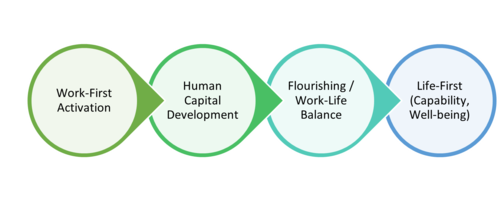Maynooth University’s ACAPES (A Collaborative Approach to building Public Employment Services) project has recently concluded a two year research programme on the provision of Public Employment Service (PES) in Ireland. The overarching aim of the project was to develop a theoretical and evidence informed PES model capable of meeting the needs of a range of job seekers and job changers, both in terms of sustainable labour market access and meaningful occupation, with a particular focus on those most distant from the labour market.
Employment Guidance
In late 2019, the project explored the employment guidance models used by the various parts of the PES with particular focus on the model most appropriate for people most distant from the labour market. Eight Local Employment Services (LES) participated in this aspect of the research, allowing the research team to observe, document and map their practice. Practitioners and stakeholders participated in focus groups and semi-structured interviews detailing client needs, service goals, and their guidance approach. This strategy allowed us to understand what actually happens in practice between the client and practitioner and identify the components of services that participants identified as enabling.
This formed the basis of what we called an employment guidance model, helping us to see that in fact the service offered a specific type of career guidance focused on enabling individuals to improve their employability, i.e. the ability to gain and maintain a job in a formal organisation and become self-sufficient in the labour market. Participants spoke about the substance of client-practitioner meetings and how topics shifted from discussing personal attributes (e.g. self-esteem, motivation, skills and abilities, interests) to environmental and social contexts (e.g. family challenges, challenges facing the community, local supports), to structural issues (e.g. reliance on social welfare, housing) and the economic context (availability of local jobs, local skill needs).
This led us to think about different types of employability, and how we could move beyond the two dominant activation approaches driving labour market policy in Ireland: Work-first and Human Capital Development. Taking into consideration the employment guidance practice encountered in the LES, we tried to progress thinking on alternative models that could underpin Irish labour market policy especially for people more distant from employment. The Work-life and Life-first models (see Figure 1) take a more person centred view and recognise meaningful work as a key component of wellbeing. We see these models as offering an alternative approach to the current predominately Work-first model underpinning the Government’s employment and activation policy Pathways to Work.
Figure 1: A labour market continuum of 'employability' models

The Work-life model focuses on empowering people, and is closely aligned with the practice of employment guidance as reported by LES practitioners, using tailored approaches which respect individual agency and understands employment participation within the context of the individual’s broader life. The Life-first model moves beyond this prioritising life needs above the obligation to work, acknowledging the time and space required to realise potential and to resolve life problems as they arise. While this may be a useful model in some instances, the continuum approach allows us to move between models depending on the needs of the person.
Model of Enabling Employment Guidance (MEEG) Toolkit and Metric
One of the key project objectives was the development of a toolkit for practitioners, and a metric to measure outcomes, particularly outcomes which are difficult to measure, such as increased self-esteem or improved career clarity. The toolkit was informed by the Flourishing/Work-life balance employability model and details what employment guidance practice looks like from this perspective. It offers practitioners and services a theoretical and practice informed service delivery model and implementation plan, detailing each stage of the process within the context of organisational ethos, practitioner skills and competence, community of practice, and leadership.
The toolkit outlines a six-stage process detailing the aims and approach, useful resources, questions to get the conversation started, and hints and tips for each stage:
- Welcome and information
- Initial personalised assessment and identification of individual need
- Career exploration
- Career decision making
- Career planning and implementation
- Ongoing support and follow-up
It includes a practitioner poster which doubles as a desktop check list to guide practice. To compliment this the MEEG metric was developed, aiming to capture the often subtle changes experienced by the person as they work with their practitioner towards employability. The MEEG metric is currently being piloted in a number of LES areas and should be available more widely in early 2022.
The MEEG resources are freely available here.
There is another article reflecting the work of this project in Issue 42 of the INOU’s e-bulletin entitled The High Road Back to Work: Developing a Public Employment Eco System for a Post-Covid Recovery and it is available here.
